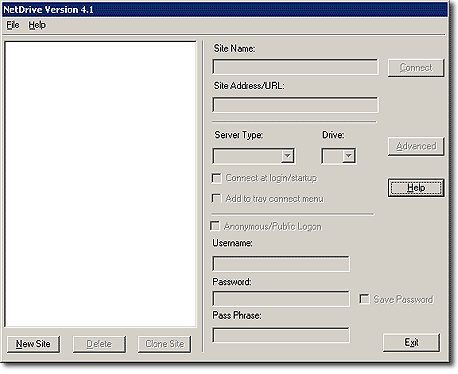

  |
Before beginning, contact your network administrator to get the following information:
Open NetDrive.
Double-click the NetDrive icon, or go to the Start menu > Programs > NetDrive.
When you open NetDrive, the NetDrive Main Window appears, as shown in the following example:
Figure 2
NetDrive Main Window
Click New Site.
A site is the way that NetDrive visually organizes the drives that you map with the NetDrive software (in this case, the word site does not refer to a Web site).
Enter the name of your site into the New Site dialog box.
A site name is simply a way for you to make your mapped drives unique and personal. There are no naming conventions that you must follow here. When the drive is mapped, a server icon, followed by the name of your site appears in the left pane of the NetDrive Main Windows.
Enter the server address that you want to connect to, then click Finish.
A server address is often referred to as a DNS name or URL. DNS stands for Domain Name Service. A DNS name is a unique name that is given to a Web server which then points to the IP address of the Web server. The advantage of using a DNS name is that it is easier to remember. For example, http://www.novell.com is a DNS name and is easier to remember than the Web server's IP address.
A URL can be a DNS name or simply the IP address of the server.
IMPORTANT: Once a server address is entered, the interface will select some default properties for you. Do not assume that these properties will automatically work with the server address that you've entered.
Select the protocol that the server is running from the Server Type drop-down box.
The following table shows what protocols are supported with each Windows operating system (if you do not know which protocol to choose, contact your network administrator):
Select a drive letter from the Drive drop-down box.
Check the Connect at Login/Startup check box if you want to connect to the server when you reboot your computer.
If you select this option, the drive that you've mapped via NetDrive will automatically connect to the server every time you boot your computer.
Determine whether you want to add the mapped drive to the Tray Connect menu.
Adds the NetDrive site to the Connect To pop-up menu. This menu lets you quickly connect to your favorite NetDrive sites without having to open the NetDrive Main Window.
Figure 3
NetDrive System Tray Icon
Determine what method you need to use to log in to your server.
IMPORTANT: iFolder uses Blowfish encryption to transfer data across the wire. WebDAV can use HTTPS for security, and FTP does not offer any security when transfering data across the wire.
Anonymous/Public login---Use this when connecting to an FTP server that allows annonymous/public login (if you're not sure, ask your network administrator). If the FTP server does not support annonymous/public login, you must enter a username and password.
Username and password---Use this when connecting to a WebDAV, FTP, or iFolder server.
Pass phrase---This field represents the iFolder pass phrase. Enter a pass phrase only if you are connecting to an iFolder server. (The pass phrase is iFolder-specific and is chosen the first time you log in into the iFolder server with the iFolder client.)
Click Connect.
Once NetDrive has successfully connected to the server, the Monitor dialog box appears. It provides you with connection status, file transfer statistics, and a connection log. Next, Windows Explorer appears with the drive letter and NetDrive site name appearing in the left pane.
The following graphic shows how a mapped drive appears in Windows Explorer:
Figure 4
Mapped Drive Appears in Windows Explorer
You can delete a NetDrive Site at any time; however, this will not affect your drive mappings in Windows Explorer. To disconnect the mapped drive, right-click the mapped drive icon in Explorer, then click Disconnect.
HINT: If you have problems getting a directory listing or connecting to a NetWare 6 server running FTP, enter the IP address of the server instead of the URL. If the problem persists, enable passive mode by clicking Advanced > PASV - Passive Mode > OK in the NetDrive Main Window. Then try connecting to the Web server again.
For FTP troubleshooting tips, see Troubleshooting FTP Problems.
Continue with the next section, "Modifying Files."
  |